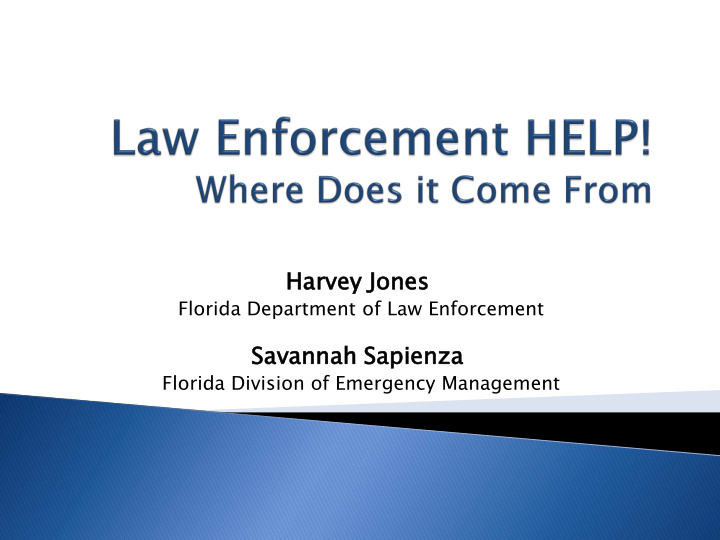



Harvey rvey Jone ones Florida Department of Law Enforcement Sa Savannah vannah Sa Sapienza ienza Florida Division of Emergency Management
How do you get help? Mutual Aid Agreements ◦ What are they? ◦ Types of Mutual Aid Agreements How does EMAC work? Reimbursement Logistics
In a local emergency or day to day operations there are mutual aid agreements in place at the local level copies are available on CJNET/Mutual Aid. When a situation expands ◦ Florida Sherriff’s Association ◦ Florida Police Chief’s Association ◦ State EOC activation
Three types 1. Voluntary Cooperation 2. Operational Assistance 3. Combined Copies pies maintained intained on the e Mutual ual Ai Aid d websi bsite te on CJNET, JNET, also so temp mpla lates tes for or all l three ree type pes s on same me website site
Activated when an incident or event exceeds the local capabilities, accompanied by a state executive order. ESF 16/Law Enforcement responds to county requests for state law enforcement.
Harvey Jones Florida Department of Law Enforcement harveyjones@fdle.state.fl.us
Presented by the Florida Division of Emergency Management
Emergency Management Assistance Compact Agreement between Governors to share resources and assets across state lines during times of disaster and emergency Nationally adopted – All 50 states, Puerto Rico, Guam, U.S. Virgin Islands and District of Columbia Ratified by Congress State to state only
What EMAC AC Does: What EMAC AC Does Not Not Do: Do: ◦ Maximizes use of all available resources ◦ Replace federal support across state lines ◦ Alter operational ◦ Coordinates deployment direction and control of resources within an ◦ Endorse assisting state self-deployment ◦ Expedites and streamlines delivery of assistance between member states
Efficiency ◦ Single document – REQ-A Legal ◦ Liability and workers compensation ◦ Assisting states guaranteed to be reimbursed Flexibility ◦ Any resource can be deployed ◦ Reciprocity of licenses and certifications ◦ Can be used for real events and training/exercises Speed ◦ Resources can be found and deployed quickly via EMAC Operations System ◦ Resources can be deployed via verbal agreement- must be followed up with signed REQ-A within 30 days
Legally binding agreements Contract for specific terms EMAC uses a three-part document that constitutes a legally binding contractual agreement (REQ-A) Defines what will be reimbursed by the requesting state
Requesting uesting State Assist isting ing State (FDEM) State Agenc ncy y Emergenc ncy y County Emergenc ncy Managers rs Coordinat dinating ing Officer icers (Alachua County EM) (FDLE) Other r Agenc ncie ies s and Subordina rdinate County Agencies cies Units s (Alachua County Sheriff’s Office, (FHP, FWC, Capitol Police) Gainesville Police Department)
Requests and offers for assistance must go through FDEM Self deployment and agreements outside EMAC channels are not protected under EMAC law and reimburseme bursement nt is not gu guarantee ranteed Reimbursement for self deployment will not be processed by FDEM
Deployed personnel should plan to be self sufficient for 3 days unless told otherwise Deployments are 14 days on ground and 2 travel days unless otherwise specified by requesting state All deployed personnel are responsible for their own expenses ◦ There are no advance funds from FDEM or the requesting state Daily situation reports must be submitted to FDEM
Deployed personnel must carry a copy of the EMAC Mission Order or the REQ-A As a rule- Florida does not send volunteers, contractors or private enterprises through EMAC Personnel sent on EMAC missions are agents of the state of Florida and must act accordingly
Self deployments are not reimbursable Reimbursement filed through DEM Finance ◦ Must have original expense receipts (signed and dated), time sheets/payroll log signed in ink by supervisor, proof of payment (pay stub), EMAC R-2 form (signed by supervisor), Florida Travel Reimbursement Voucher ◦ Submitted to FDEM within 45 days of return Reimbursement does not go directly to the team- it goes to the resource provider May take several months to a year
Resource Deployed Providers Assisting State Requesting State Personnel (St. Louis (MSEMA) (FDEM) (Jon Jay) County) Resource Deployed Providers Assisting State Requesting State Personnel (St. Louis (MSEMA) (FDEM) (Jon Jay) County)
MRPs drastically speed up the offer for assistance by outlining capabilities, assets and associated costs Can be uploaded into the EMAC Operations System MRP templates are available on the EMAC website
MRP’s are documents that allow resource providers (county or municipal agencies) to describe a resource or capability they may deploy
In-state sharing of resources and assets between parties during times of emergency Operates similarly to EMAC, but for in-state resources Parties to the agreement can include counties, cities, educational districts, colleges, universities, special districts, authorities, Native American tribes and community development districts
Requests must go through county emergency management agencies Requests can be made orally, but must be followed up in writing within 5 days by the county emergency management agency of the requesting party Requesting party responsible for reimbursement of costs incurred by assisting party
Assisting parties responsible for providing insurance for its employees while providing assistance to another party Current agreement is dated August 20, 2007 Not necessary to resign the agreement if your jurisdiction has previously signed If your contact information needs to be updated fill out Form C and submit it to FDEM
Requesting party County emergency management agency FDEM or other participating parties All requests for out of state or FEMA resources and assistance must go through FDEM
www.emacweb.org ◦ Official EMAC website ◦ Training, information, videos, and MRP info accessible to the public http://www.floridadisaster.org/Response/Operat ions/EMAC/index.htm ◦ FDEM EMAC and SMAA website Savannah Sapienza, State EMAC Coordinator, FDEM Savannah.sapienza@em.myflorida.com (850) 413-9886
Recommend
More recommend